SBM 4303: Enterprise Architecture (EA) Assignment: Complete Solution
VerifiedAdded on 2023/06/04
|22
|5074
|51
Homework Assignment
AI Summary
This document presents a detailed solution to an Enterprise Architecture assignment, covering topics such as the differences between EA and systems-level planning, the elements of an EA management program, and the role of EA in various enterprises. It addresses the importance of understanding the 'people side' of EA, compares and contrasts organizations and enterprises, and identifies academic fields influencing EA. The solution also explains the Parsons/Thompson Model, the Organization Network Model, and stakeholder management within EA programs. Furthermore, it discusses strategies for managing change with stakeholders and explores the structural and cultural aspects captured by EA in a large enterprise. The document also covers EA implementation methodologies, frameworks, components, and artifacts, providing a comprehensive understanding of enterprise architecture principles and practices.

Running Head: USE OF EA
0
[Type the company name]
Enterprise Architecture (EA)
[Type the document subtitle]
Student
[Pick the date]
0
[Type the company name]
Enterprise Architecture (EA)
[Type the document subtitle]
Student
[Pick the date]
Paraphrase This Document
Need a fresh take? Get an instant paraphrase of this document with our AI Paraphraser
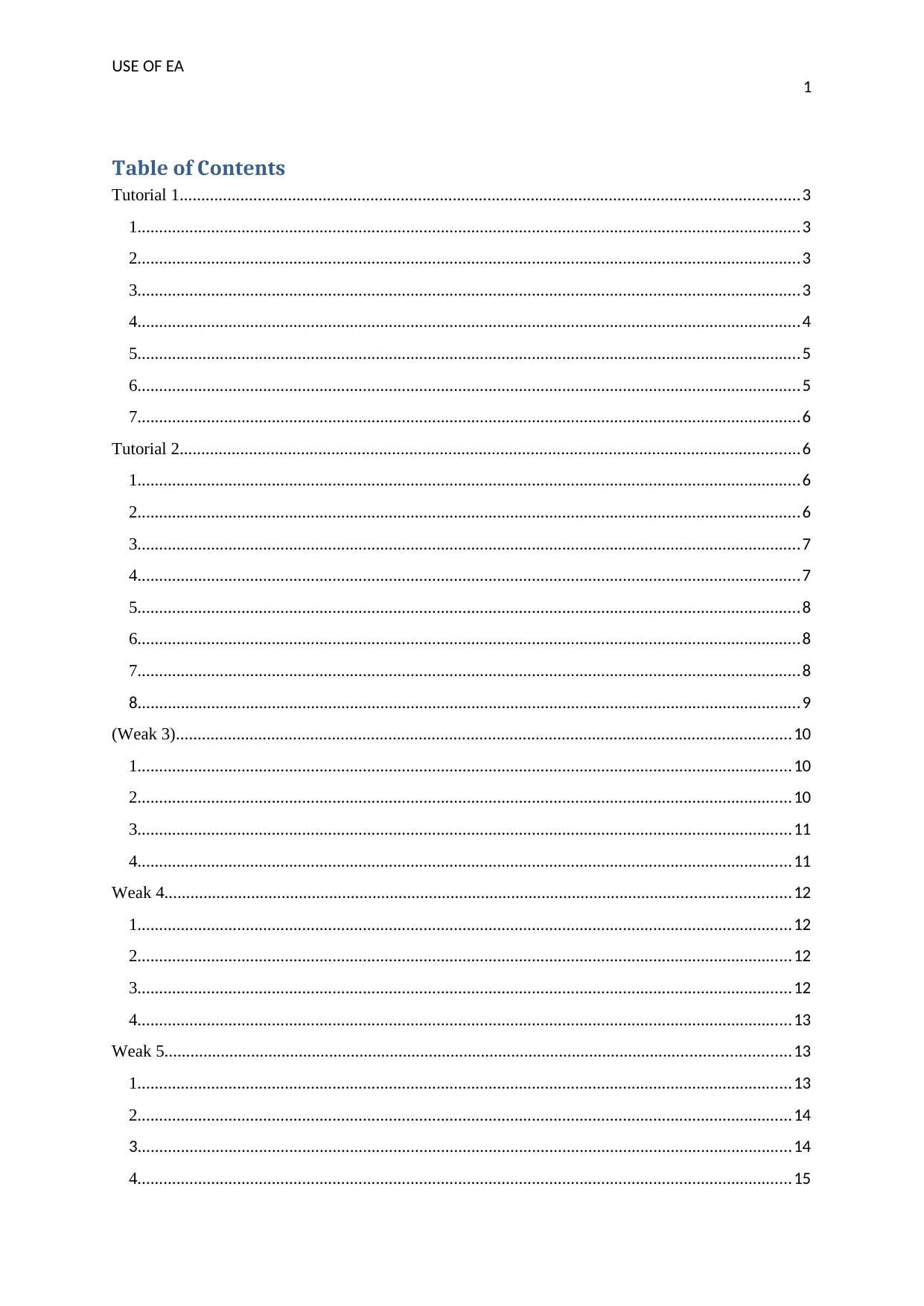
USE OF EA
1
Table of Contents
Tutorial 1...............................................................................................................................................3
1.........................................................................................................................................................3
2.........................................................................................................................................................3
3.........................................................................................................................................................3
4.........................................................................................................................................................4
5.........................................................................................................................................................5
6.........................................................................................................................................................5
7.........................................................................................................................................................6
Tutorial 2...............................................................................................................................................6
1.........................................................................................................................................................6
2.........................................................................................................................................................6
3.........................................................................................................................................................7
4.........................................................................................................................................................7
5.........................................................................................................................................................8
6.........................................................................................................................................................8
7.........................................................................................................................................................8
8.........................................................................................................................................................9
(Weak 3)..............................................................................................................................................10
1.......................................................................................................................................................10
2.......................................................................................................................................................10
3.......................................................................................................................................................11
4.......................................................................................................................................................11
Weak 4................................................................................................................................................12
1.......................................................................................................................................................12
2.......................................................................................................................................................12
3.......................................................................................................................................................12
4.......................................................................................................................................................13
Weak 5................................................................................................................................................13
1.......................................................................................................................................................13
2.......................................................................................................................................................14
3.......................................................................................................................................................14
4.......................................................................................................................................................15
1
Table of Contents
Tutorial 1...............................................................................................................................................3
1.........................................................................................................................................................3
2.........................................................................................................................................................3
3.........................................................................................................................................................3
4.........................................................................................................................................................4
5.........................................................................................................................................................5
6.........................................................................................................................................................5
7.........................................................................................................................................................6
Tutorial 2...............................................................................................................................................6
1.........................................................................................................................................................6
2.........................................................................................................................................................6
3.........................................................................................................................................................7
4.........................................................................................................................................................7
5.........................................................................................................................................................8
6.........................................................................................................................................................8
7.........................................................................................................................................................8
8.........................................................................................................................................................9
(Weak 3)..............................................................................................................................................10
1.......................................................................................................................................................10
2.......................................................................................................................................................10
3.......................................................................................................................................................11
4.......................................................................................................................................................11
Weak 4................................................................................................................................................12
1.......................................................................................................................................................12
2.......................................................................................................................................................12
3.......................................................................................................................................................12
4.......................................................................................................................................................13
Weak 5................................................................................................................................................13
1.......................................................................................................................................................13
2.......................................................................................................................................................14
3.......................................................................................................................................................14
4.......................................................................................................................................................15
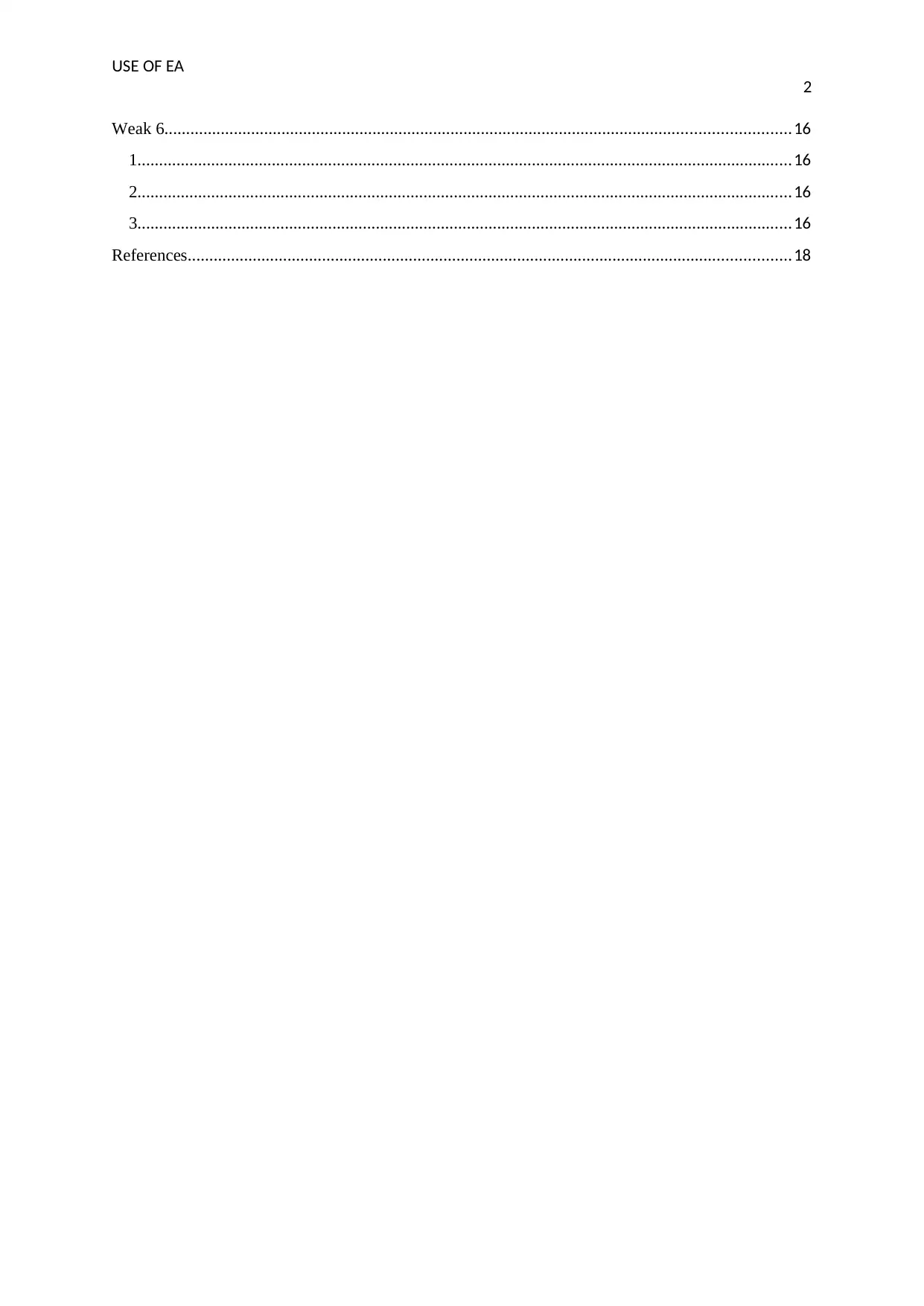
USE OF EA
2
Weak 6................................................................................................................................................16
1.......................................................................................................................................................16
2.......................................................................................................................................................16
3.......................................................................................................................................................16
References...........................................................................................................................................18
2
Weak 6................................................................................................................................................16
1.......................................................................................................................................................16
2.......................................................................................................................................................16
3.......................................................................................................................................................16
References...........................................................................................................................................18
⊘ This is a preview!⊘
Do you want full access?
Subscribe today to unlock all pages.

Trusted by 1+ million students worldwide
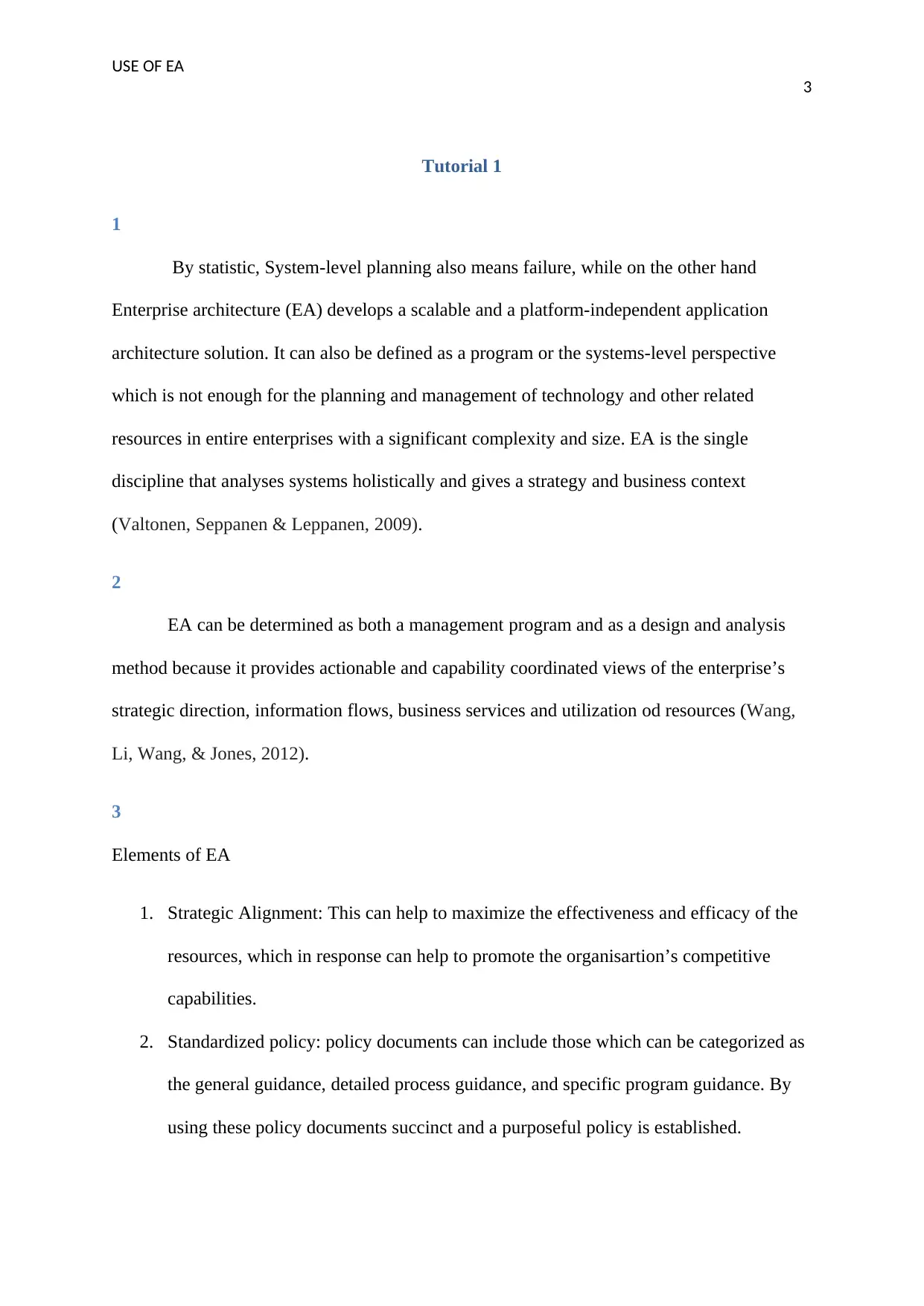
USE OF EA
3
Tutorial 1
1
By statistic, System-level planning also means failure, while on the other hand
Enterprise architecture (EA) develops a scalable and a platform-independent application
architecture solution. It can also be defined as a program or the systems-level perspective
which is not enough for the planning and management of technology and other related
resources in entire enterprises with a significant complexity and size. EA is the single
discipline that analyses systems holistically and gives a strategy and business context
(Valtonen, Seppanen & Leppanen, 2009).
2
EA can be determined as both a management program and as a design and analysis
method because it provides actionable and capability coordinated views of the enterprise’s
strategic direction, information flows, business services and utilization od resources (Wang,
Li, Wang, & Jones, 2012).
3
Elements of EA
1. Strategic Alignment: This can help to maximize the effectiveness and efficacy of the
resources, which in response can help to promote the organisartion’s competitive
capabilities.
2. Standardized policy: policy documents can include those which can be categorized as
the general guidance, detailed process guidance, and specific program guidance. By
using these policy documents succinct and a purposeful policy is established.
3
Tutorial 1
1
By statistic, System-level planning also means failure, while on the other hand
Enterprise architecture (EA) develops a scalable and a platform-independent application
architecture solution. It can also be defined as a program or the systems-level perspective
which is not enough for the planning and management of technology and other related
resources in entire enterprises with a significant complexity and size. EA is the single
discipline that analyses systems holistically and gives a strategy and business context
(Valtonen, Seppanen & Leppanen, 2009).
2
EA can be determined as both a management program and as a design and analysis
method because it provides actionable and capability coordinated views of the enterprise’s
strategic direction, information flows, business services and utilization od resources (Wang,
Li, Wang, & Jones, 2012).
3
Elements of EA
1. Strategic Alignment: This can help to maximize the effectiveness and efficacy of the
resources, which in response can help to promote the organisartion’s competitive
capabilities.
2. Standardized policy: policy documents can include those which can be categorized as
the general guidance, detailed process guidance, and specific program guidance. By
using these policy documents succinct and a purposeful policy is established.
Paraphrase This Document
Need a fresh take? Get an instant paraphrase of this document with our AI Paraphraser

USE OF EA
4
3. Decision Support: Enterprise’s Architecture provides a support for IT resources
decision-making at the executive, staff and management level of the enterprise.
4. Resources Oversight: EA supports the application of a better process for selecting and
examining investment in the IT resources from a financial and business perspective.
Six-element of an EA
1. Framework: it identifies the scope for developing architecture and establishes a
relationship between the areas of architecture.
2. Components: EA components are basically the changeable goals, standards,
processes, and resources that can extend enterprise wide or can be contained within a
specific line of segment or business.
3. Current Architecture: it contains those Enterprises architecture components that are
currently present with the enterprise at every single level of the framework.
4. Future architecture: it documents those latest or modified components of EA that are
required by the enterprise to fill an performance gap and support the new strategic
initiative, technology solution and operational requirement
5. EA management plan: it basically articulates the Enterprise architecture program and
the documentation approach; it can provide descriptions of present and upcoming
views of the architecture.
6. Threads: the documentation contains threads of general activities that are present in
all levels of the framework. The threads can incudes its standards, the standards and
skill consideration (Lankhorst, 2009).
4
Documentation (Artefacts) describing an organization's current goals and initiatives
are a strategic plan, SWOT analysis approach, existing operating scenario & the operating
4
3. Decision Support: Enterprise’s Architecture provides a support for IT resources
decision-making at the executive, staff and management level of the enterprise.
4. Resources Oversight: EA supports the application of a better process for selecting and
examining investment in the IT resources from a financial and business perspective.
Six-element of an EA
1. Framework: it identifies the scope for developing architecture and establishes a
relationship between the areas of architecture.
2. Components: EA components are basically the changeable goals, standards,
processes, and resources that can extend enterprise wide or can be contained within a
specific line of segment or business.
3. Current Architecture: it contains those Enterprises architecture components that are
currently present with the enterprise at every single level of the framework.
4. Future architecture: it documents those latest or modified components of EA that are
required by the enterprise to fill an performance gap and support the new strategic
initiative, technology solution and operational requirement
5. EA management plan: it basically articulates the Enterprise architecture program and
the documentation approach; it can provide descriptions of present and upcoming
views of the architecture.
6. Threads: the documentation contains threads of general activities that are present in
all levels of the framework. The threads can incudes its standards, the standards and
skill consideration (Lankhorst, 2009).
4
Documentation (Artefacts) describing an organization's current goals and initiatives
are a strategic plan, SWOT analysis approach, existing operating scenario & the operating
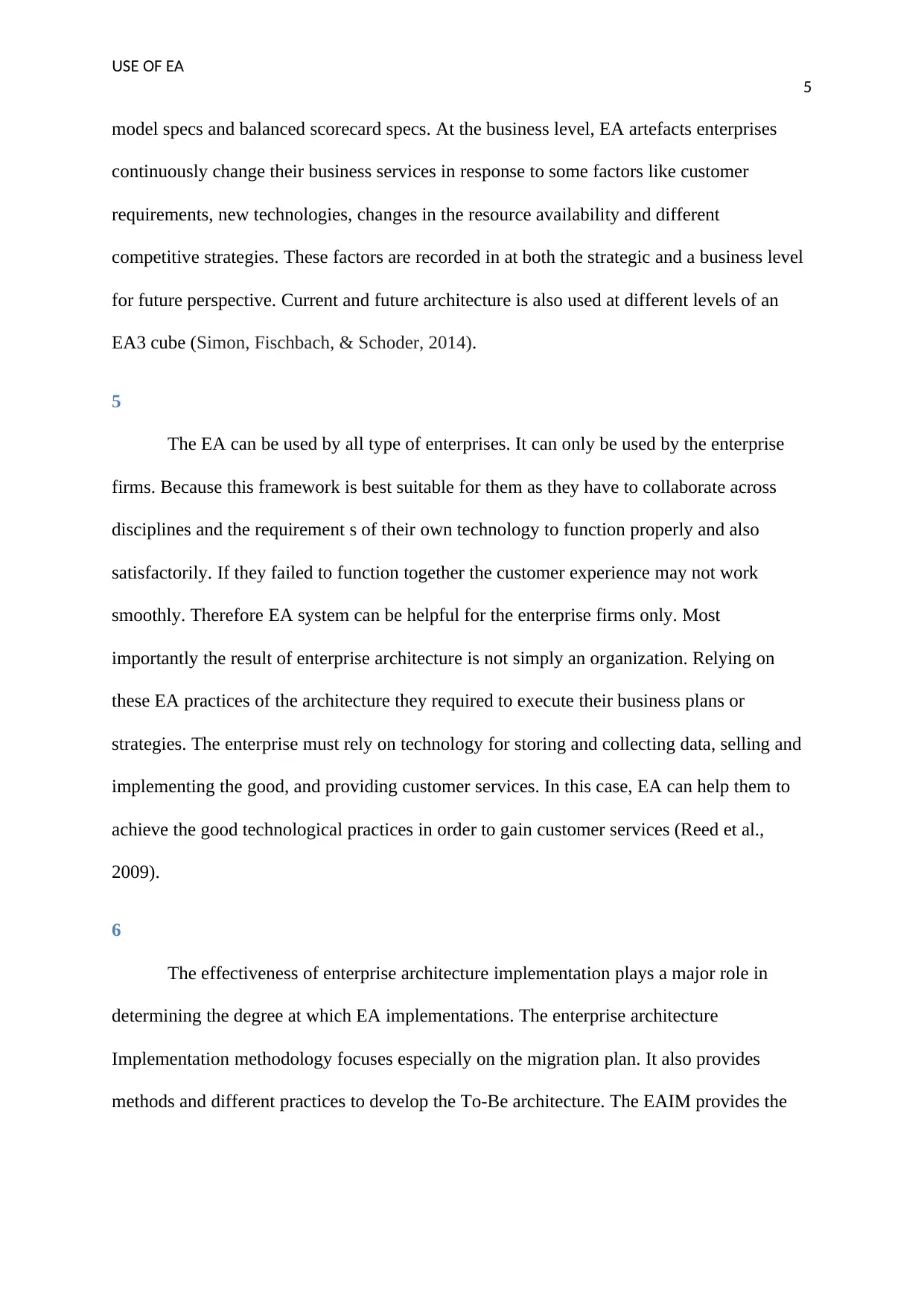
USE OF EA
5
model specs and balanced scorecard specs. At the business level, EA artefacts enterprises
continuously change their business services in response to some factors like customer
requirements, new technologies, changes in the resource availability and different
competitive strategies. These factors are recorded in at both the strategic and a business level
for future perspective. Current and future architecture is also used at different levels of an
EA3 cube (Simon, Fischbach, & Schoder, 2014).
5
The EA can be used by all type of enterprises. It can only be used by the enterprise
firms. Because this framework is best suitable for them as they have to collaborate across
disciplines and the requirement s of their own technology to function properly and also
satisfactorily. If they failed to function together the customer experience may not work
smoothly. Therefore EA system can be helpful for the enterprise firms only. Most
importantly the result of enterprise architecture is not simply an organization. Relying on
these EA practices of the architecture they required to execute their business plans or
strategies. The enterprise must rely on technology for storing and collecting data, selling and
implementing the good, and providing customer services. In this case, EA can help them to
achieve the good technological practices in order to gain customer services (Reed et al.,
2009).
6
The effectiveness of enterprise architecture implementation plays a major role in
determining the degree at which EA implementations. The enterprise architecture
Implementation methodology focuses especially on the migration plan. It also provides
methods and different practices to develop the To-Be architecture. The EAIM provides the
5
model specs and balanced scorecard specs. At the business level, EA artefacts enterprises
continuously change their business services in response to some factors like customer
requirements, new technologies, changes in the resource availability and different
competitive strategies. These factors are recorded in at both the strategic and a business level
for future perspective. Current and future architecture is also used at different levels of an
EA3 cube (Simon, Fischbach, & Schoder, 2014).
5
The EA can be used by all type of enterprises. It can only be used by the enterprise
firms. Because this framework is best suitable for them as they have to collaborate across
disciplines and the requirement s of their own technology to function properly and also
satisfactorily. If they failed to function together the customer experience may not work
smoothly. Therefore EA system can be helpful for the enterprise firms only. Most
importantly the result of enterprise architecture is not simply an organization. Relying on
these EA practices of the architecture they required to execute their business plans or
strategies. The enterprise must rely on technology for storing and collecting data, selling and
implementing the good, and providing customer services. In this case, EA can help them to
achieve the good technological practices in order to gain customer services (Reed et al.,
2009).
6
The effectiveness of enterprise architecture implementation plays a major role in
determining the degree at which EA implementations. The enterprise architecture
Implementation methodology focuses especially on the migration plan. It also provides
methods and different practices to develop the To-Be architecture. The EAIM provides the
⊘ This is a preview!⊘
Do you want full access?
Subscribe today to unlock all pages.

Trusted by 1+ million students worldwide
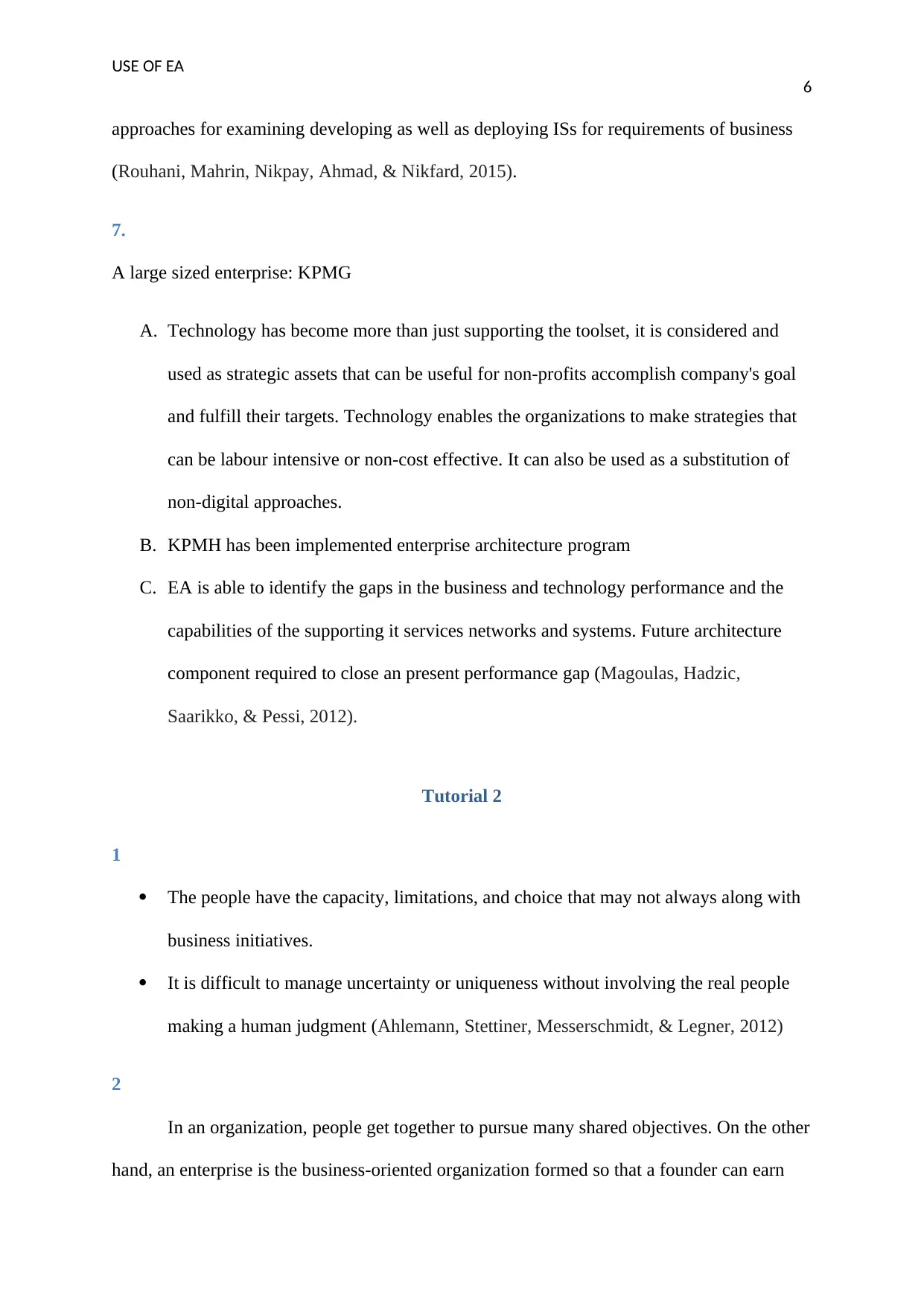
USE OF EA
6
approaches for examining developing as well as deploying ISs for requirements of business
(Rouhani, Mahrin, Nikpay, Ahmad, & Nikfard, 2015).
7.
A large sized enterprise: KPMG
A. Technology has become more than just supporting the toolset, it is considered and
used as strategic assets that can be useful for non-profits accomplish company's goal
and fulfill their targets. Technology enables the organizations to make strategies that
can be labour intensive or non-cost effective. It can also be used as a substitution of
non-digital approaches.
B. KPMH has been implemented enterprise architecture program
C. EA is able to identify the gaps in the business and technology performance and the
capabilities of the supporting it services networks and systems. Future architecture
component required to close an present performance gap (Magoulas, Hadzic,
Saarikko, & Pessi, 2012).
Tutorial 2
1
The people have the capacity, limitations, and choice that may not always along with
business initiatives.
It is difficult to manage uncertainty or uniqueness without involving the real people
making a human judgment (Ahlemann, Stettiner, Messerschmidt, & Legner, 2012)
2
In an organization, people get together to pursue many shared objectives. On the other
hand, an enterprise is the business-oriented organization formed so that a founder can earn
6
approaches for examining developing as well as deploying ISs for requirements of business
(Rouhani, Mahrin, Nikpay, Ahmad, & Nikfard, 2015).
7.
A large sized enterprise: KPMG
A. Technology has become more than just supporting the toolset, it is considered and
used as strategic assets that can be useful for non-profits accomplish company's goal
and fulfill their targets. Technology enables the organizations to make strategies that
can be labour intensive or non-cost effective. It can also be used as a substitution of
non-digital approaches.
B. KPMH has been implemented enterprise architecture program
C. EA is able to identify the gaps in the business and technology performance and the
capabilities of the supporting it services networks and systems. Future architecture
component required to close an present performance gap (Magoulas, Hadzic,
Saarikko, & Pessi, 2012).
Tutorial 2
1
The people have the capacity, limitations, and choice that may not always along with
business initiatives.
It is difficult to manage uncertainty or uniqueness without involving the real people
making a human judgment (Ahlemann, Stettiner, Messerschmidt, & Legner, 2012)
2
In an organization, people get together to pursue many shared objectives. On the other
hand, an enterprise is the business-oriented organization formed so that a founder can earn
Paraphrase This Document
Need a fresh take? Get an instant paraphrase of this document with our AI Paraphraser
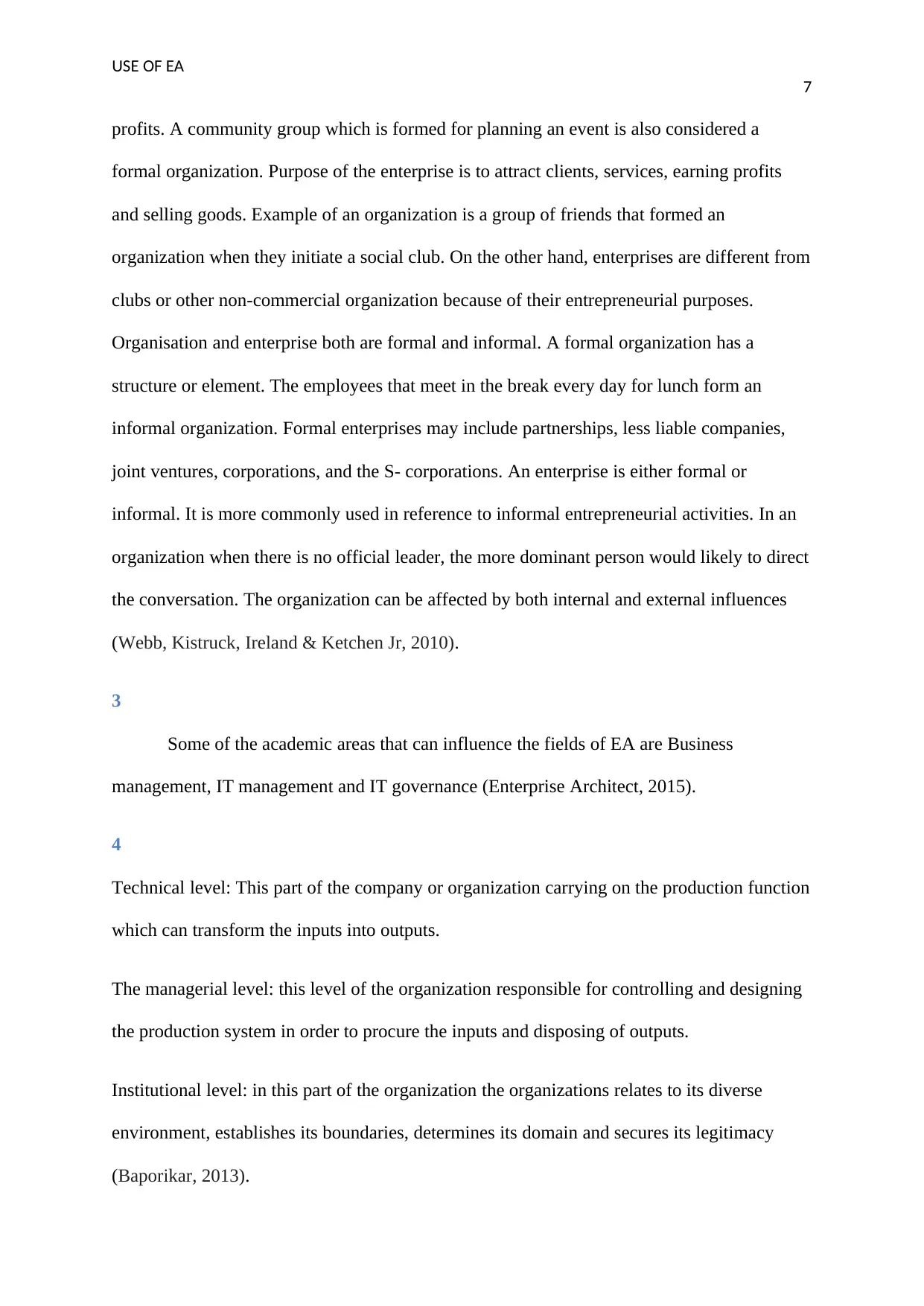
USE OF EA
7
profits. A community group which is formed for planning an event is also considered a
formal organization. Purpose of the enterprise is to attract clients, services, earning profits
and selling goods. Example of an organization is a group of friends that formed an
organization when they initiate a social club. On the other hand, enterprises are different from
clubs or other non-commercial organization because of their entrepreneurial purposes.
Organisation and enterprise both are formal and informal. A formal organization has a
structure or element. The employees that meet in the break every day for lunch form an
informal organization. Formal enterprises may include partnerships, less liable companies,
joint ventures, corporations, and the S- corporations. An enterprise is either formal or
informal. It is more commonly used in reference to informal entrepreneurial activities. In an
organization when there is no official leader, the more dominant person would likely to direct
the conversation. The organization can be affected by both internal and external influences
(Webb, Kistruck, Ireland & Ketchen Jr, 2010).
3
Some of the academic areas that can influence the fields of EA are Business
management, IT management and IT governance (Enterprise Architect, 2015).
4
Technical level: This part of the company or organization carrying on the production function
which can transform the inputs into outputs.
The managerial level: this level of the organization responsible for controlling and designing
the production system in order to procure the inputs and disposing of outputs.
Institutional level: in this part of the organization the organizations relates to its diverse
environment, establishes its boundaries, determines its domain and secures its legitimacy
(Baporikar, 2013).
7
profits. A community group which is formed for planning an event is also considered a
formal organization. Purpose of the enterprise is to attract clients, services, earning profits
and selling goods. Example of an organization is a group of friends that formed an
organization when they initiate a social club. On the other hand, enterprises are different from
clubs or other non-commercial organization because of their entrepreneurial purposes.
Organisation and enterprise both are formal and informal. A formal organization has a
structure or element. The employees that meet in the break every day for lunch form an
informal organization. Formal enterprises may include partnerships, less liable companies,
joint ventures, corporations, and the S- corporations. An enterprise is either formal or
informal. It is more commonly used in reference to informal entrepreneurial activities. In an
organization when there is no official leader, the more dominant person would likely to direct
the conversation. The organization can be affected by both internal and external influences
(Webb, Kistruck, Ireland & Ketchen Jr, 2010).
3
Some of the academic areas that can influence the fields of EA are Business
management, IT management and IT governance (Enterprise Architect, 2015).
4
Technical level: This part of the company or organization carrying on the production function
which can transform the inputs into outputs.
The managerial level: this level of the organization responsible for controlling and designing
the production system in order to procure the inputs and disposing of outputs.
Institutional level: in this part of the organization the organizations relates to its diverse
environment, establishes its boundaries, determines its domain and secures its legitimacy
(Baporikar, 2013).
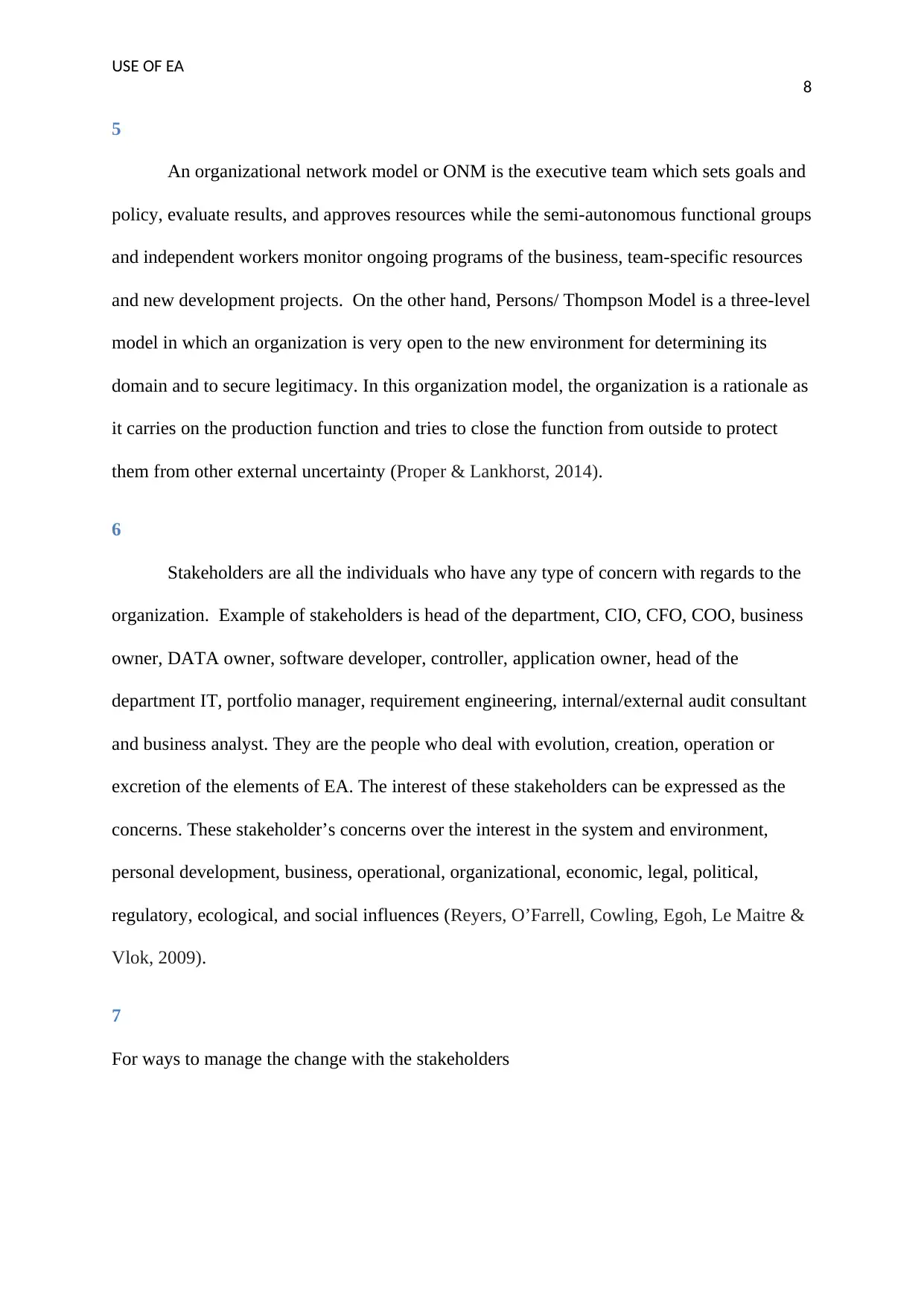
USE OF EA
8
5
An organizational network model or ONM is the executive team which sets goals and
policy, evaluate results, and approves resources while the semi-autonomous functional groups
and independent workers monitor ongoing programs of the business, team-specific resources
and new development projects. On the other hand, Persons/ Thompson Model is a three-level
model in which an organization is very open to the new environment for determining its
domain and to secure legitimacy. In this organization model, the organization is a rationale as
it carries on the production function and tries to close the function from outside to protect
them from other external uncertainty (Proper & Lankhorst, 2014).
6
Stakeholders are all the individuals who have any type of concern with regards to the
organization. Example of stakeholders is head of the department, CIO, CFO, COO, business
owner, DATA owner, software developer, controller, application owner, head of the
department IT, portfolio manager, requirement engineering, internal/external audit consultant
and business analyst. They are the people who deal with evolution, creation, operation or
excretion of the elements of EA. The interest of these stakeholders can be expressed as the
concerns. These stakeholder’s concerns over the interest in the system and environment,
personal development, business, operational, organizational, economic, legal, political,
regulatory, ecological, and social influences (Reyers, O’Farrell, Cowling, Egoh, Le Maitre &
Vlok, 2009).
7
For ways to manage the change with the stakeholders
8
5
An organizational network model or ONM is the executive team which sets goals and
policy, evaluate results, and approves resources while the semi-autonomous functional groups
and independent workers monitor ongoing programs of the business, team-specific resources
and new development projects. On the other hand, Persons/ Thompson Model is a three-level
model in which an organization is very open to the new environment for determining its
domain and to secure legitimacy. In this organization model, the organization is a rationale as
it carries on the production function and tries to close the function from outside to protect
them from other external uncertainty (Proper & Lankhorst, 2014).
6
Stakeholders are all the individuals who have any type of concern with regards to the
organization. Example of stakeholders is head of the department, CIO, CFO, COO, business
owner, DATA owner, software developer, controller, application owner, head of the
department IT, portfolio manager, requirement engineering, internal/external audit consultant
and business analyst. They are the people who deal with evolution, creation, operation or
excretion of the elements of EA. The interest of these stakeholders can be expressed as the
concerns. These stakeholder’s concerns over the interest in the system and environment,
personal development, business, operational, organizational, economic, legal, political,
regulatory, ecological, and social influences (Reyers, O’Farrell, Cowling, Egoh, Le Maitre &
Vlok, 2009).
7
For ways to manage the change with the stakeholders
⊘ This is a preview!⊘
Do you want full access?
Subscribe today to unlock all pages.

Trusted by 1+ million students worldwide
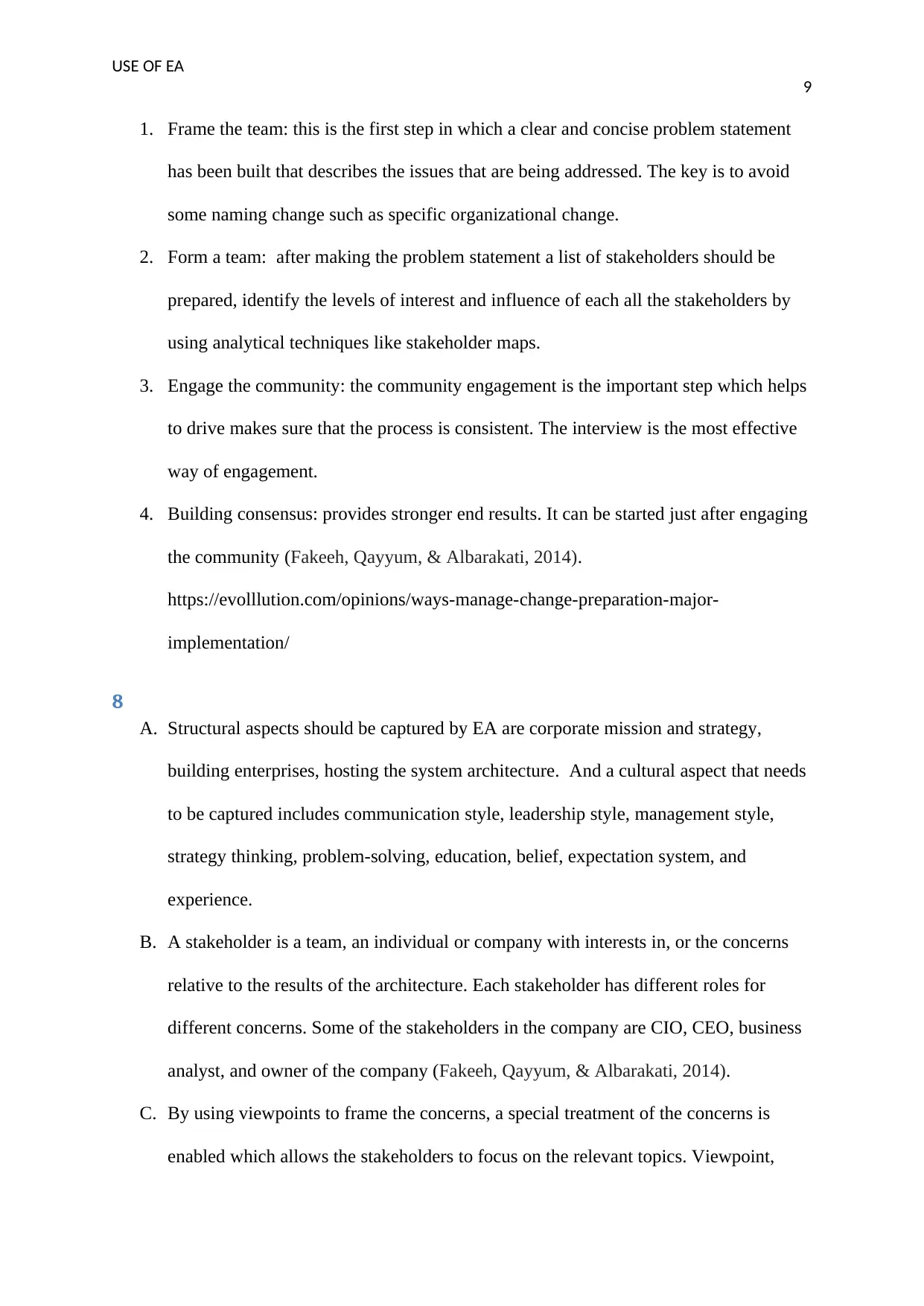
USE OF EA
9
1. Frame the team: this is the first step in which a clear and concise problem statement
has been built that describes the issues that are being addressed. The key is to avoid
some naming change such as specific organizational change.
2. Form a team: after making the problem statement a list of stakeholders should be
prepared, identify the levels of interest and influence of each all the stakeholders by
using analytical techniques like stakeholder maps.
3. Engage the community: the community engagement is the important step which helps
to drive makes sure that the process is consistent. The interview is the most effective
way of engagement.
4. Building consensus: provides stronger end results. It can be started just after engaging
the community (Fakeeh, Qayyum, & Albarakati, 2014).
https://evolllution.com/opinions/ways-manage-change-preparation-major-
implementation/
8
A. Structural aspects should be captured by EA are corporate mission and strategy,
building enterprises, hosting the system architecture. And a cultural aspect that needs
to be captured includes communication style, leadership style, management style,
strategy thinking, problem-solving, education, belief, expectation system, and
experience.
B. A stakeholder is a team, an individual or company with interests in, or the concerns
relative to the results of the architecture. Each stakeholder has different roles for
different concerns. Some of the stakeholders in the company are CIO, CEO, business
analyst, and owner of the company (Fakeeh, Qayyum, & Albarakati, 2014).
C. By using viewpoints to frame the concerns, a special treatment of the concerns is
enabled which allows the stakeholders to focus on the relevant topics. Viewpoint,
9
1. Frame the team: this is the first step in which a clear and concise problem statement
has been built that describes the issues that are being addressed. The key is to avoid
some naming change such as specific organizational change.
2. Form a team: after making the problem statement a list of stakeholders should be
prepared, identify the levels of interest and influence of each all the stakeholders by
using analytical techniques like stakeholder maps.
3. Engage the community: the community engagement is the important step which helps
to drive makes sure that the process is consistent. The interview is the most effective
way of engagement.
4. Building consensus: provides stronger end results. It can be started just after engaging
the community (Fakeeh, Qayyum, & Albarakati, 2014).
https://evolllution.com/opinions/ways-manage-change-preparation-major-
implementation/
8
A. Structural aspects should be captured by EA are corporate mission and strategy,
building enterprises, hosting the system architecture. And a cultural aspect that needs
to be captured includes communication style, leadership style, management style,
strategy thinking, problem-solving, education, belief, expectation system, and
experience.
B. A stakeholder is a team, an individual or company with interests in, or the concerns
relative to the results of the architecture. Each stakeholder has different roles for
different concerns. Some of the stakeholders in the company are CIO, CEO, business
analyst, and owner of the company (Fakeeh, Qayyum, & Albarakati, 2014).
C. By using viewpoints to frame the concerns, a special treatment of the concerns is
enabled which allows the stakeholders to focus on the relevant topics. Viewpoint,
Paraphrase This Document
Need a fresh take? Get an instant paraphrase of this document with our AI Paraphraser
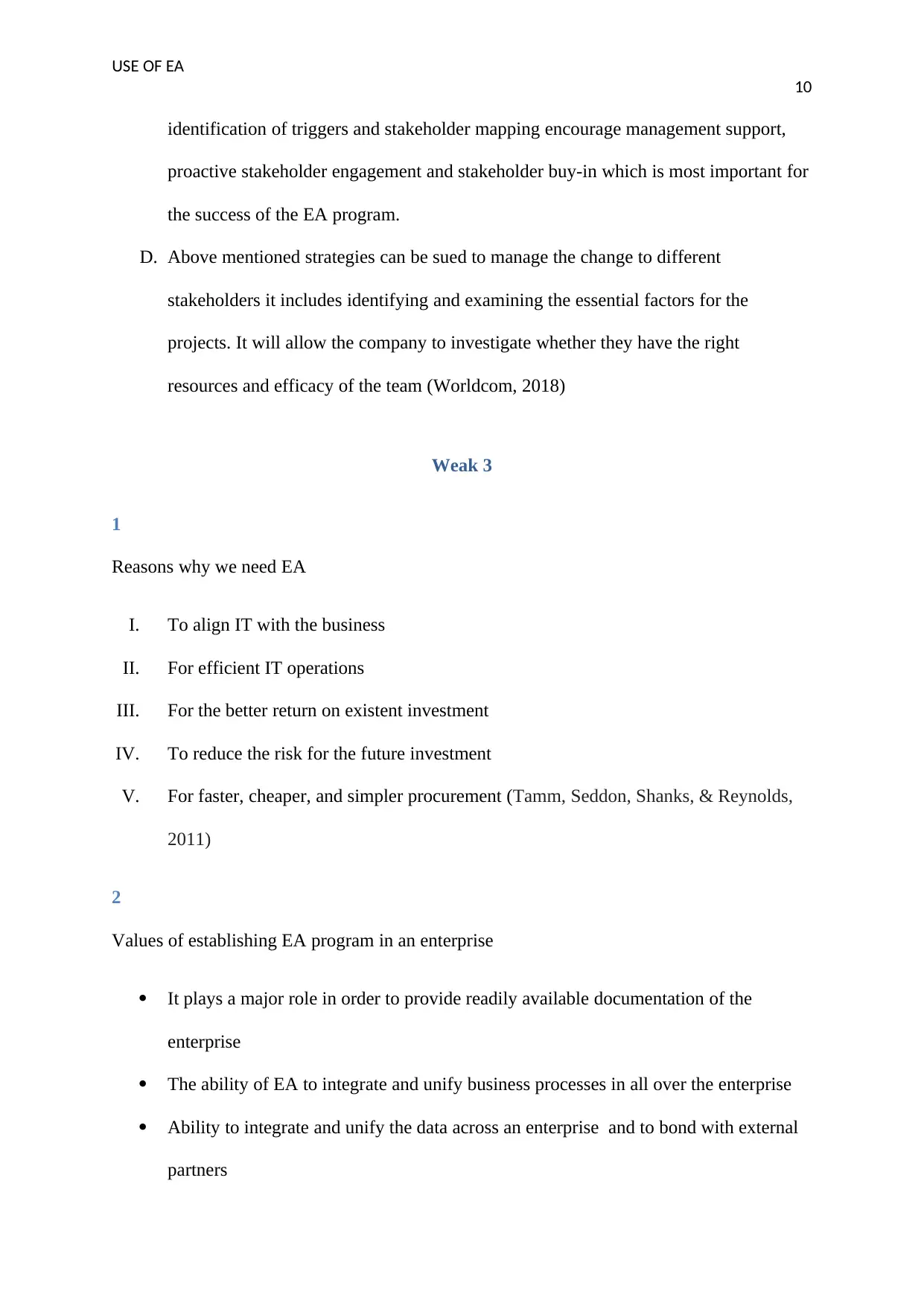
USE OF EA
10
identification of triggers and stakeholder mapping encourage management support,
proactive stakeholder engagement and stakeholder buy-in which is most important for
the success of the EA program.
D. Above mentioned strategies can be sued to manage the change to different
stakeholders it includes identifying and examining the essential factors for the
projects. It will allow the company to investigate whether they have the right
resources and efficacy of the team (Worldcom, 2018)
Weak 3
1
Reasons why we need EA
I. To align IT with the business
II. For efficient IT operations
III. For the better return on existent investment
IV. To reduce the risk for the future investment
V. For faster, cheaper, and simpler procurement (Tamm, Seddon, Shanks, & Reynolds,
2011)
2
Values of establishing EA program in an enterprise
It plays a major role in order to provide readily available documentation of the
enterprise
The ability of EA to integrate and unify business processes in all over the enterprise
Ability to integrate and unify the data across an enterprise and to bond with external
partners
10
identification of triggers and stakeholder mapping encourage management support,
proactive stakeholder engagement and stakeholder buy-in which is most important for
the success of the EA program.
D. Above mentioned strategies can be sued to manage the change to different
stakeholders it includes identifying and examining the essential factors for the
projects. It will allow the company to investigate whether they have the right
resources and efficacy of the team (Worldcom, 2018)
Weak 3
1
Reasons why we need EA
I. To align IT with the business
II. For efficient IT operations
III. For the better return on existent investment
IV. To reduce the risk for the future investment
V. For faster, cheaper, and simpler procurement (Tamm, Seddon, Shanks, & Reynolds,
2011)
2
Values of establishing EA program in an enterprise
It plays a major role in order to provide readily available documentation of the
enterprise
The ability of EA to integrate and unify business processes in all over the enterprise
Ability to integrate and unify the data across an enterprise and to bond with external
partners
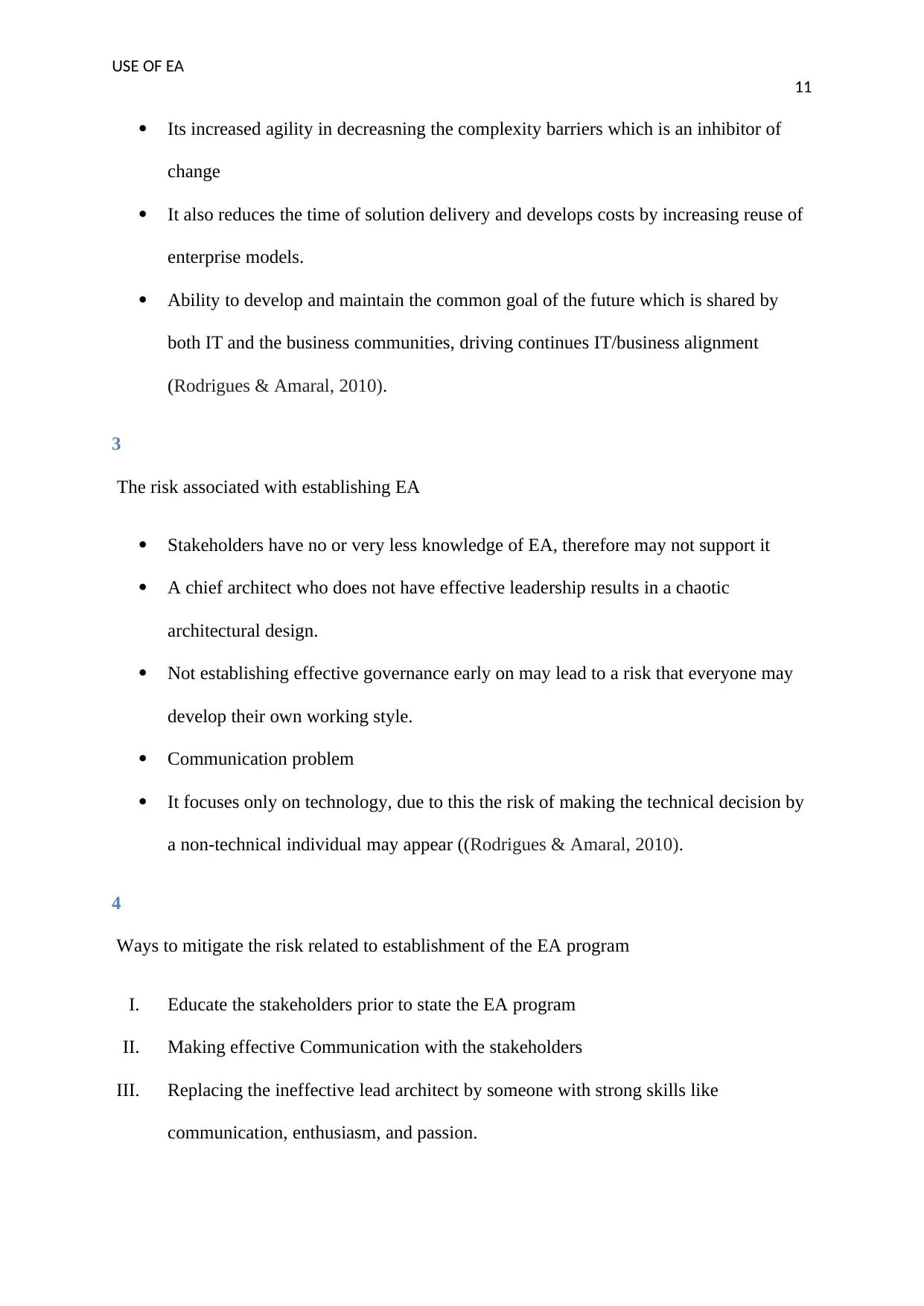
USE OF EA
11
Its increased agility in decreasning the complexity barriers which is an inhibitor of
change
It also reduces the time of solution delivery and develops costs by increasing reuse of
enterprise models.
Ability to develop and maintain the common goal of the future which is shared by
both IT and the business communities, driving continues IT/business alignment
(Rodrigues & Amaral, 2010).
3
The risk associated with establishing EA
Stakeholders have no or very less knowledge of EA, therefore may not support it
A chief architect who does not have effective leadership results in a chaotic
architectural design.
Not establishing effective governance early on may lead to a risk that everyone may
develop their own working style.
Communication problem
It focuses only on technology, due to this the risk of making the technical decision by
a non-technical individual may appear ((Rodrigues & Amaral, 2010).
4
Ways to mitigate the risk related to establishment of the EA program
I. Educate the stakeholders prior to state the EA program
II. Making effective Communication with the stakeholders
III. Replacing the ineffective lead architect by someone with strong skills like
communication, enthusiasm, and passion.
11
Its increased agility in decreasning the complexity barriers which is an inhibitor of
change
It also reduces the time of solution delivery and develops costs by increasing reuse of
enterprise models.
Ability to develop and maintain the common goal of the future which is shared by
both IT and the business communities, driving continues IT/business alignment
(Rodrigues & Amaral, 2010).
3
The risk associated with establishing EA
Stakeholders have no or very less knowledge of EA, therefore may not support it
A chief architect who does not have effective leadership results in a chaotic
architectural design.
Not establishing effective governance early on may lead to a risk that everyone may
develop their own working style.
Communication problem
It focuses only on technology, due to this the risk of making the technical decision by
a non-technical individual may appear ((Rodrigues & Amaral, 2010).
4
Ways to mitigate the risk related to establishment of the EA program
I. Educate the stakeholders prior to state the EA program
II. Making effective Communication with the stakeholders
III. Replacing the ineffective lead architect by someone with strong skills like
communication, enthusiasm, and passion.
⊘ This is a preview!⊘
Do you want full access?
Subscribe today to unlock all pages.

Trusted by 1+ million students worldwide
1 out of 22
Related Documents
Your All-in-One AI-Powered Toolkit for Academic Success.
+13062052269
info@desklib.com
Available 24*7 on WhatsApp / Email
![[object Object]](/_next/static/media/star-bottom.7253800d.svg)
Unlock your academic potential
Copyright © 2020–2025 A2Z Services. All Rights Reserved. Developed and managed by ZUCOL.





